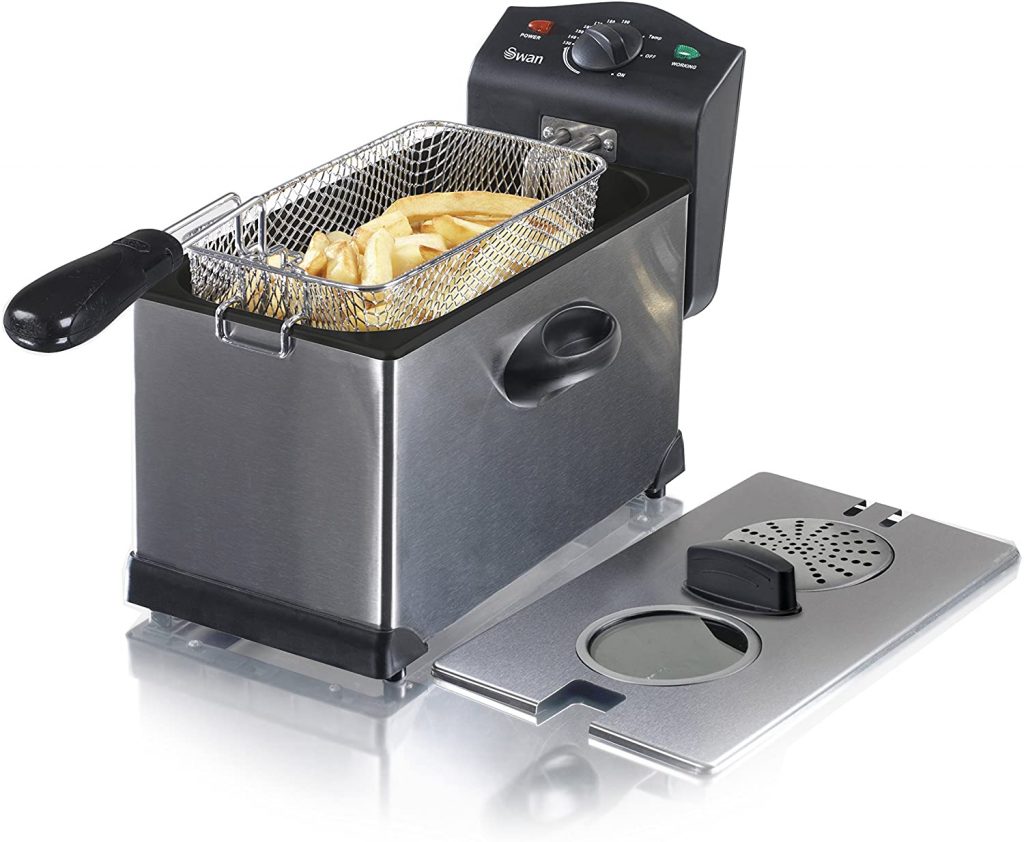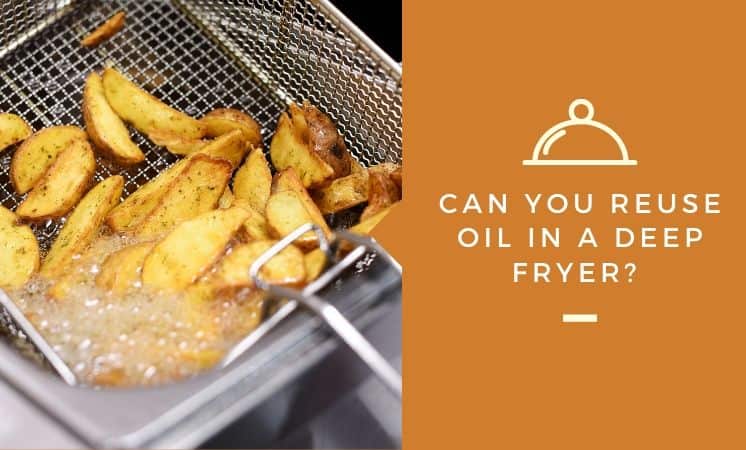How Often Should a Deep Fryers Oil Be Changed?

How often should you change the oil in a deep fryer? This is a subject that customers and employees alike frequently ask.
What I discovered is as follows:
For non-breaded veggies, deep fryer oil should be changed after 6-8 uses, and for breaded foods, fatty meats, and fish, after 2-4 uses.
But there’s a lot more to deep-frying oil than that, from how to determine if it’s gone rancid to how to dispose of it properly when it’s time to replace it.
So, let’s get this party started.
In a deep fryer, how long can oil last?
Keep your deep fryer oil in the refrigerator for no more than three months. Allow for 2 hours of cooling time after heating the unit and oil. Using a strainer or cheesecloth, pour the oil into a container. To get the best effects, cover the container with a lid and refrigerate.
The length of time you’re cooking oil lasts before it needs to be replaced is determined by a number of factors, including:
- How frequently do you use it? (On a daily, weekly, or monthly basis?)
- What are you frying in it? (for example, fish has a different effect than potatoes)
- Do you fry a lot of breaded items? (Which leaves much debris in the oil)
- What type of oil do you use? (Peanut or vegetable oils that have been refined last longer)
There are a few things to think about before deciding whether to change the oil in your deep fryer. There isn’t a one-size-fits-all method to understanding when to change the oil in a deep fryer.
What are the telltale signals that “old” oil needs to be replaced?

- The foam covers the oil’s surface (when hot).
- Even if you haven’t been frying fish, you’ll notice a fishy odor.
- The oil is now far more flammable than it was previously.
- A color that is much darker than the original.
- If you absolutely must have a number, consider the following as a reference, but always utilize your senses (including common sense!) to make your decision.
- Also, keep in mind that oil used in a deep fryer lasts longer than oil used in a skillet.
Type of food you fry most often
An approximate number of uses before changing is needed
French fries, other non-breaded items: 6-8 uses
Breaded or crumbly foods: 3-4 uses
Fish (breaded): 2-3 uses
Vegetables (non-breaded): 6-8 uses
Meats & Poultry (non-breaded): 3-4 uses (with fattier foods like bacon, air on the low side)
Is it possible to reuse oil in a deep fryer?

Yes, the oil from a deep fryer can be reused. After the oil has cooled (approximately 2 hours), squeeze it into an airtight container with a cover using a filter or cheesecloth. For optimal effects, keep it refrigerated. Continue to use the oil for up to 8-10 times more or until the color or odor has faded.
The Maillard reaction, which occurs in deep fryers, causes food to become crispy.
The Maillard reaction refers to a chemical interaction between the amino acids in the oil. It is named after French chemist Louis-Camille Maillard. This gives the dish a crisp texture and darkens both the food and the oil’s color.
Unfortunately, the longer you continue this, the shorter the oil’s lifespan becomes. When it comes to reusing oil in a deep fryer, the best plan is to clean it after each use and store it correctly.
Follow these steps to clean your deep fryer oil (or skillet cooking oil):
- Remove any food particles or debris with a skimmer.
- Pour the oil into a clean, dry pot through a filter.
- Before you reach the bottom of the oil, come to a halt (where there may be more debris)
- Allow the saucepan to cool completely before covering it.
- Pour the oil back into the original bottle or any other airtight container using a funnel.
- Store in a cold, dark spot away from windows and heat sources like a stove, just like any other oil.
Restaurants should change frying oil every so often:
Most restaurants will want to change their oil twice a week if they utilize their deep fryer(s) on a regular basis. On the other hand, some restaurants may have a single fryer specialized in fish or breaded dishes, which would necessitate more regular adjustments.
The usage of deep fryers in restaurants are obviously lot more than fryers or skillets in household kitchens.
It’s also true that restaurants can’t afford to serve subpar meals due to stale oil. Bad ratings and fewer visits are the results of mediocre meals.
Just keep in mind that restaurants will (ideally) change their oil much more frequently than we do at home.
Another factor to consider is that many restaurants have many deep fryers. As a result, there are sections dedicated to meats and fish, as well as those dedicated to vegetables. This limits the items that break down frying oil quickly to one of their fryers rather than all of them.
Other factors to consider are:
- Replace your oil completely as needed, rather than topping it off.
- After the food has come out of the frying, season it with salt.
- Lower the temperature of the frying to roughly 375°F.
- Every three months, give the fryer a thorough cleaning.
If you enjoy French fries but prefer to buy bags of frozen fries rather than the more time-consuming approach of cutting your own, you may be wondering if you can fry them.
In brief, while some people bake frozen French fries, deep frying them is much better.
What’s the best way to get rid of deep fryer oil?
Allow the deep fryer oil to cool and solidify before discarding it. After that, put the oil in a box or a double-layered plastic bag and throw it away. Do not pour it down the drain or into your yard while it is hot, as it will destroy the grass.
This is a huge deal because there are many things you shouldn’t do with fryer oil.
Restaurants have a grease trap, which is essentially a container for holding used cooking oil. When the vessel is complete, they call a service to come to take up the oil.
You can assume it was the grease-trap emptying day if you’ve ever stood outside a fast-food restaurant and seen a big truck and smelt something foul!
Let’s start with what not to do in a home kitchen:
- Don’t flush it down the toilet.
- Pouring it in the yard is not a good idea (it will kill or at least discolor the grass)
- Pouring into a compost bin or pile is not a good idea.
The best course of action is to:
- Allow cooling before pouring into a lidded container and discarding.
- After it has cooled, place it in a basin, freeze it until it is thick, and then shovel it into the garbage.
It’s also worth noting that, thanks to the emergence of the biodiesel business in the last decade or two, many restaurants now sell their waste cooking oil to be converted into biodiesel fuel.
I’m not aware of that being accessible for home usage, but it would be worth looking into in your area if you use much oil.
How can you determine whether the frying oil you’re using is terrible?
When you notice foam, the coloring is substantially darker, or it smells awful, you know your frying oil is rotten. Frying oil progresses from good to bad, darkening in color and becoming harsher and sourer in scent.
When it comes to the frying oil, it doesn’t change from good to poor overnight.
The stages are as follows:
- Foam or frothiness on the oil’s surface (when hot).
- The color will be much darker than it is now.
- It will have an unpleasant odor.
But, in addition to the oil-degrading, it can also go rancid, which is even worse.
Rancidity, also known as “hydrolytic rancidity,” is a condition in which oil begins to break down due to oxidation. This breaks down the oil into fatty acids, which have a foul odor.
Coconut oil and lard, for example, are less prone to go rancid than other oils because they solidify at ambient temperature. Oils that have previously been heated in the packaging process, such as any oil branded “toasted,” are the most prone to get rancid.
There are a few symptoms to look for to see if your oil is rancid, including:
- It smells soapy, bitter, or chemically similar to paint thinner.
- Beyond being heavy, the oil feels sticky when poured on your finger.
The following are some of the things that can cause the oil to get rancid:
- The heat that is excessive (being too close to the stove)
- Too much exposure to the sun (sitting in front of the window on your kitchen counter)
- Age (that 2-year-old bottle of roasted sesame oil in your pantry)
Before you assume anything, this only applies to fryer or cooking oil, keep in mind that old, out-of-date bags of chips on the supermarket shelves, as well as any packaged product containing oil, can go rancid. Fortunately, detecting rancidity in a bag of chips is relatively simple.
Is it possible that I answered all of your queries concerning how often you should change the oil in a deep fryer?
We looked at the world of deep fryers and cooking oil in this post.
We looked at how often to change the oil, what foods cause it to go bad faster, how to clean it, and how to dispose of used cooking oil properly.
Finally, we came up with a range of 2-3 uses for fatty meats, fish, or breaded products and up to 6-8 uses for clean veggies when answering the question of how often you should replace the oil in a deep fryer. However, it would be best always to use your senses to inspect the oil before each usage.











